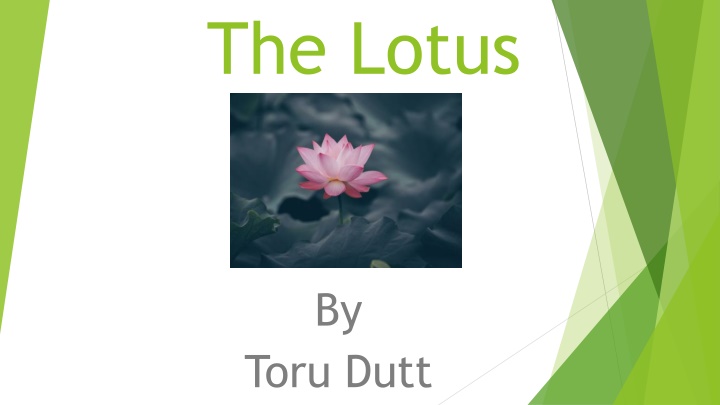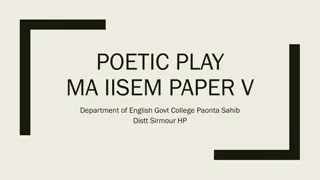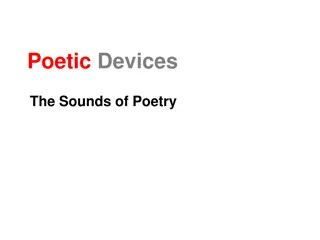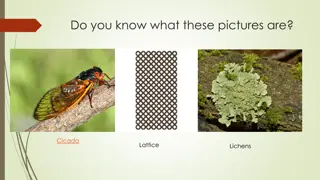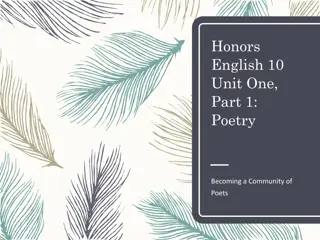The Lotus by Toru Dutt - Poetic Exploration of Love and Beauty
Toru Dutt, a prominent figure in Indo-Anglian literature, beautifully captures the essence of love and beauty in her poem "The Lotus". Through vivid imagery and elegant verses, she delves into the rivalry between the rose and the lily for the title of the queen of flowers. Ultimately, Flora presents the lotus as the epitome of beauty, blending the colors of the rose and the purity of the lily. This classic piece of poetry reflects Dutt's thematic exploration of loneliness, longing, and patriotism.
Download Presentation

Please find below an Image/Link to download the presentation.
The content on the website is provided AS IS for your information and personal use only. It may not be sold, licensed, or shared on other websites without obtaining consent from the author.If you encounter any issues during the download, it is possible that the publisher has removed the file from their server.
You are allowed to download the files provided on this website for personal or commercial use, subject to the condition that they are used lawfully. All files are the property of their respective owners.
The content on the website is provided AS IS for your information and personal use only. It may not be sold, licensed, or shared on other websites without obtaining consent from the author.
E N D
Presentation Transcript
The Lotus By Toru Dutt
Toru Dutt Toru Dut (4 a Bengali translator and poet from British India, who wrote in English and French. She is among the founding figures of Indo-Anglian literature, alongside Henry Louis Vivian Derozio (1809 1831), Manmohan Ghose (1869 1924), and Sarojini Naidu (1879 1949). March 1856 30 August 1877) was She is known for her volumes of poetry in English, A Sheaf Gleaned in French Fields (1877) and Ancient Ballads and Legends of Hindustan (1882), and for a novel in French, Le Journal de Mademoiselle d'Arvers (1879). Her poems explore themes of loneliness, longing, patriotism and nostalgia. Dutt died at the age of 21.
The Lotus Love came to Flora asking for a flower That would of flowers be undisputed queen, The lily and the rose, long, long had been Rivals for that high honour. Bards of power Had sung their claims. The rose can never tower Like the pale lily with her Juno mien - But is the lily lovelier? Thus between Flower-factions rang the strife in Psyche s bower.
Give me a flower delicious as the rose And stately as the lily in her pride - But of what colour? - Rose-red, Love first chose, Then prayed, - No, lily-white,-or, both provide ; And Flora gave the lotus, rose-red dyed, And lily-white, - the queenliest flower that blows.
Glossary Flora Roman goddess of flowers undisputed unquestioned Juno wife of Jupiter, queen of heaven, goddess of light mien appearance, bearing strife struggle psyche- a princess loved by Cupid (the Roman god love) Rivals competitor, challenger Bards poets Tower stand like a tower Fractions division, section Delicious delightful, pleasant
In classical mythology, Cupid (Latin Cup d meaning "passionate desire") is the god of desire, erotic love, attraction affection. He portrayed as the son of the love goddess Venus and the god of war Mars. He is also known in Latin ("Love"). [k pi do ], and often is as Amor
Flora, in Roman religion, the goddess of the flowering of plants. Tatius (according tradition, the Sabine king who ruled with Romulus) is said to have introduced her cult to Rome; her temple stood near Maximus. Titus to the Circus
Juno Roman goddess of marriage and childbirth. She is also the chief Roman Queen Gods (Regina Deorum) and female of Jupiter. She is the wife and sister to King Jupiter. Juno is considered as the protector and counselor of state. is the ancient goddess, of the counterpart special roman the
Lily Rose
Analysis Love came to Flora asking for a flower Love came to Flora asking for a flower The first 8 lines describe a situation that arises in Psyche s bower. A bower is a sheltered, cool part of a garden and is a pleasant area to sit in. Here, Love approaches Flora and asks her for a flower that can be called the queen of all flowers. There are already two flowers vying for this title, that is, the lily and the rose. Many poets (bards) who were highly influential claimed that the rose could never reach the stature of the lily, and the lily could never have the beauty of the rose. Because of these uncertainties, was argument and debate between the two camps, and neither the lily nor the rose came out victorious. That would of flowers be undisputed That would of flowers be undisputed queen, queen, The lily and the rose, long, long had been The lily and the rose, long, long had been Rivals for that high honour. Bards of Rivals for that high honour. Bards of power power Had sung their claims. The rose can Had sung their claims. The rose can never tower never tower Like the pale lily with her Juno mien Like the pale lily with her Juno mien - - But is the lily lovelier? Thus between But is the lily lovelier? Thus between Flower Flower- -factions rang the strife in factions rang the strife in Psyche s bower. Psyche s bower.
This poet uses several characters from Roman mythology in the story she tells through this poem. Love can be seen as Cupid, the Roman god of love. Flora is the Roman goddess of flowering plants and the season goddess Juno is the Queen of the gods, and the Roman goddess Psyche is the wife of Cupid. of spring. The Roman The lily is a flower that is native to areas of the Northern Hemisphere, like Europe, or the United States. In the poem, the lily represents the standards of beauty of the West and is symbolic of the belief that their beauty and standards are the best. The lily flower also is compared to the goddess Juno. Juno, as the queen of the gods, is well known for her elegance and majestic looks. The lily s Juno mien is the flower s own stateliness and sophisticated air. Mien means the appearance or demeanour of someone, and in this case, the lily s mien was one of royalty.
The rose is a flower that is native to Central Asia, and is representative of the opposite of the Euro-centric standards of beauty, and symbolises the natural beauty of those that do not necessarily live up to the standards set by European countries and the like. In poetry, the rose is symbolic of love and beauty, and this beauty is unattainable even to the lily. The flower garden is at an impasse, as neither candidate for queendom wins over the other. There is strife between these two, in deciding who comes out victorious. In the context of beauty, the strife is between the acceptance of Eurocentric ideals of beauty and the acceptance of Eastern ideals of beauty. Neither win over the other, and must learn to co-exist.
Give me a flower delicious as the Give me a flower delicious as the rose rose And stately as the lily in her pride And stately as the lily in her pride - - But of what colour? But of what colour? - - Rose Love first chose, Love first chose, Then prayed, Then prayed, - - No, lily No, lily- -white, both provide ; both provide ; And Flora gave the lotus, rose And Flora gave the lotus, rose- -red dyed, dyed, And lily And lily- -white, white, - - the queenliest flower that blows. flower that blows. The volta of the Petrarchan sonnet is seen here, as the problem that was brought up earlier gets resolved. Unable to choose between the stately lily and the beautiful rose, Love asks Flora to instead give him a flower that combines the best of both. Rose- -red, red, white,- -or, or, This indecision between the lily and the rose is brought forth again when Love was not able to choose a colour. He could not decide between the beautiful rose-red, or the elegant lily-white. He finally compromise, a mix of both. red hit upon the best the queenliest
To fulfil his wish, the goddess provided the lotus flower, a mix of both the rose and the lily, the true queen of the garden. This lotus represents India and the Hindu religion. The poet is portraying the Hindu religion as the one that is superior to all others, as the lotus is superior to all other flowers in Psyche s garden. The lotus flower is the national flower of India, and it is also revered by Hindus. Many deities like Saraswati, or Brahma, sit at a throne that is modelled after the lotus flower. It is a symbol of enlightenment and purity the divinity of the gods. Using this lotus, Dutt expresses that the Hindu religion triumphs over all others. and is the expression of However, this poem is not seen only through the eyes of religion. This intermingling of cultures to bring about a better result is also representative of how the standards of beauty reach a compromise accepted by all. The ideals of both factions are combined as the lily and rose are combined, to create a beauty that emerges from the mix of both.
